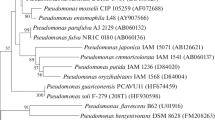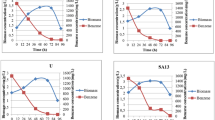Abstract
The strain Streptomyces rochei 303 (VKM Ac-1284D) is capable of utilizing 2-chloro-,2,4-,2,6-dichloro- and 2,4,6-trichlorophenols as the sole source of carbon. Its resting cells completely dechlorinated and degraded 2-, 3-chloro-; 2,4-, 2,6-, 2,3-, 2,5-, 3,4-, 3,5-dichloro-; 2,4-, 2,6-dibromo-; 2,4,6-, 2,4,5-, 2,3,4-, 2,3,5-, 2,3,6-trichlorophenols; 2,3,5,6-tetrachloro- and pentachlorophenol. During chlorophenol degradation, a stoichiometric amount of chloride ions was released and chlorohydroquinols were formed as intermediates. In cell-free extracts of S. rochei, the activity of hydroxyquinol 1,2-dioxygenase was found. The enzyme was induced with chlorophenols. Of all so far described strains degrading polychlorophenols, S. rochei 303 utilized a wider range of chlorinated phenols as the sole sourse of carbon and energy.
Similar content being viewed by others
Abbreviations
- CP:
-
chlorophenol
- DCP:
-
dichlorophenol
- TCP:
-
trichlorophenol
- TeCP:
-
tetrachlorophenol
- PCP:
-
pentachlorophenol
- DBrP:
-
dibromophenol
- CHQ:
-
chlorohydroquinol
- DCHQ:
-
dichlorohydroquinol
- HHQ:
-
hydroxyhydroquinol
- CHHQ:
-
chlorohydroxyhydroquinol
- CC:
-
chlorocatechol
- TLC:
-
thin layer chromatography
- GC/MC:
-
chromato-mass-spectrometry
- HPLC:
-
high-performance liquid chromatography
References
Apajalachti JA & Salkinoja-Salonen MS (1986) Degradation of polychlorinated phenols by Rhodococcus chlorophenolicus. Appl. Microbiol. Biotechnol. 25:62–67
Apajalachti JA & Salkinoja-Salonen MS (1987a) Dechlorination and para-hydroxylation of polychlorinated phenols by Rhodococcus chlorophenolicus. J. Bacteriol. 169: 675–681
Apajalachti JHA & Salkinoja-Salonen MS (1987b) Complete dechlorination of tetrachlorohydroquinone by cell extracts of pentachlorophenol-induced Rhodococcus chlorophenolicus. J. Bacteriol. 169: 5124–5130
Chapman PJ & Ribbons LW (1976) Metabolism of resorcinolic compounds by bacteria: alternative pathways for resorcinol catabolism in Pseudomonas putida. J. Bacteriol. 125: 985–998
Chu JI & Kirsch EJ (1973) Utilization of halophenols by a pentachlorophenol metabolizing bacterium. Develop. Ind. Microb. 14: 264–273
Dakin HD (1909) The oxidation of hydroxy derivatives of benzaldehyde, acetophenone and related substances. Am. Chem. J. 42: 477–498
Dorn E & Knackmuss H-J (1978) Chemical structure and biodegradability of halogenated aromatic compounds. Two catechol 1,2-dioxygenases from a 3-chlorobenzoate-grown pseudomonad. Biochem. J. 174: 73–84
Dorn E & Knackmuss H-J (1980) Chemical structure and biodegradability of halogenated aromatic compounds. J. Biochem. 174: 73–84
Fetzner S, Muller R & Lingens F (1989) Degradation of 2-chlorobenzoate by Pseudomonas cepacia 2CBS. Biol. Chem. Hoppe-Seyler 370: 1173–1182
Florence TM, Farrar YJ & Heights L (1971) Spectrophotometric determination of chloride at the parts-per-billion level by the mercury (II) thiocyanate method. Analytica Chimica Acta 54: 373–377
Gaal A & Neujahr HY (1979) Metabolism of phenol and resorcinol in Trichosporon cutaneum. J. Bacteriol. 137: 13–21
Gorlatov SN, Maltseva OV, Shevchenko BF & Golovleva LA (1989) Degradation of chlorophenols by the culture Rhodococcus erythropolis. Mikrobiologiya 58: 802–806 (in Russian)
Golovleva LA, Pertsova RN, Maltseva OV & Zaborina OE (1991) Enzymatic degradation of polychlorinated phenol components of pulp and paper industry wastes and effluents. VTT Symposium 122 ‘Bioconversion of plant raw materials-biotechnology advancement’, Finnish-Soviet Seminar Mustio 14–16 March, 1990, Espoo: 70-81
Häggblom MM, Nohynek LJ & Salkinoja-Salonen NS (1988) Degradation and o-methylation of chlorinated phenolic compounds by Rhodococcus and Mycobacterium strains. Appl. Environ. Microbiol. 54: 3034–3052
Kirchner JC (1978) Thin-layer chromatography, v. 1. Wiley & Sons, Inc., New York
Knackmuss H-J & Hellwig M (1978) Utilization and cooxidation of chlorinated phenols by Pseudomonas sp. B13. Arch. Microbiol. 117: 1–7
Lowry OH, Rosebrough HJ, Farr AL & Randall RJ (1951) Protein measurement with the Folin phenol reagent. J. Biol. Chem. 193: 265–275
Nakazawa T & Nakazawa A (1970) Pyrocatechase (Pseudomonas). In: Tabor H & Tabor CW (eds) Methods in Enzymology, vol. 17A (pp. 518–522). Academic Press, New York and London
Nozaki M (1970) Metapyrocatechase. In: Tabor H & Tabor CW (eds) Methods in Enzymology. vol. 17A (pp. 522–526) Academic Press, New York and London
Oae S, Kiritani R & Tagaki W (1966) The Oxygen Exchange Reaction of Phenol in Acidic Media. Bulletin of The Chemical Society of Japan 39: 1961–1967
Saber D & Crawford RL (1985) Isolation and characterization of Flavobacterium strains that degrade pentachlorophenol. Appl. Environ. Microbiol. 50: 1512–1518
Schlenk H & Hellerman J (1960) Esterification of fatty acids with diazomethane on a small scale. Anal. Chem. 32: 1412–1414
Spain JC & Gibson DT (1988) Oxidation of substituted phenols by Pseudomonas putida F1 and Pseudomonas sp. strain JS6. Appl. Environ. Microbiol. 54: 1399–1404
Steiert IG, Pignatello J & Crawford R (1987) Degradation of chlorinated phenols by a pentachlorophenol-degrading bacterium. Appl. Environ. Microbiol. 53: 907–910
Sze JS-Y & Dagley S (1984) Properties of salicylate hydroxylase and hydrohyquinol 1,2-dioxygenase purified from Trichosporon cutaneum. J. Bacteriol. 159: 353–359
Szokolay A & Madaric A (1969) Eindimensional dunnschicht Chromatographie chlorierter Insektizide auf Fertigplatten mit mehrfacher Entwicklung. J. Chromatogr. 42: 509–519
Williams ST, Goodfellow M, Alderson G, Wellington EMH, Sneath PH & Sackin HJ (1983) Numerical classification of Streptomyces and related genera. J. General Microbiol. 129: 1743–1813
Author information
Authors and Affiliations
Rights and permissions
About this article
Cite this article
Golovleva, L.A., Zaborina, O., Pertsova, R. et al. Degradation of polychlorinated phenols by Streptomyces rochei 303. Biodegradation 2, 201–208 (1991). https://doi.org/10.1007/BF00124494
Accepted:
Issue Date:
DOI: https://doi.org/10.1007/BF00124494




